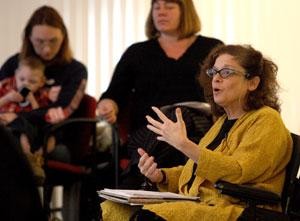The UA’s Disability Studies Initiative, a program developed out of the Disability Resource Center, hopes to engage the campus community in the discussion on disability as a field of study.
Simi Linton, a writer and disability activist, presented her memoir “”My Body Politic: An Illustrated History,”” yesterday in the Student Union Memorial Center, as part of the center’s outreach campaign.
“”Disability still is not understood by the general public as a social justice issue; it’s seen as a health issue,”” she said. “”People think, ‘Just put some ramps up and they’ll shut up,’ but it is a human rights issue.””
Linton said she was impressed by the DRC’s work at the UA.
“”I am bowled over about what is happening at the UA,”” she said. “”The DRC and their agenda is profound and it’s pretty darn easy getting around this campus.””
Mayleah Koop, a communication freshman and member of the UA’s wheelchair basketball team, said easy access and a “”disabled-friendly”” environment was a major factor in her decision to attend the UA.
“”I was told that getting in and out of buildings was easy, and the overall ability to live and move around campus was good, so it was definitely a major factor,”” she said.
DRC director Sue Kroeger said 1,500 UA students use the DRC’s service office, accounting for about 4 percent of the student body.
Aside from reading selected passages from her memoir, Linton’s presentation included sound, images and video as well as interactive audience presentation. Her memoir begins with the United States at war in Vietnam and ends with the U.S. entangled in Iraq, portraying disability in a social and political context in the first act, and incorporating its artistic context in the second act.
“”Are you ready to go back to 1975?”” Linton asked as she began her presentation by describing the day that changed her life.
While on her way to Washington, D.C. to protest the Vietnam War in 1971, along with a friend and her husband at the time, a car accident left her husband and friend dead and Linton with a spinal injury that cut off mobility to her legs.
“”Along with the reconciliation of my new state, I learned what it meant to be a disabled person in America,”” she said.
Linton described the hardships associated with everyday life for a disabled person at a time when the disability rights movement was barely beginning to gain momentum.
Linton moved to Berkeley, Calif. in the summer of 1975, and was surprised by its progressiveness.
“”Berkeley was way ahead of the country in disability rights and access,”” she said. “”The problem was not that I couldn’t walk, but that society was configured for those who could.””
Linton showed footage of a few disability rights demonstrations; notably in 1990, when more than 100 disabled people were arrested for protesting in front of the U.S. Capitol Building, even crawling up the steps in an act that helped pave the way for the Americans with Disabilities Act later that year, making discrimination against disabled people illegal.
She compared the Vietnam War to the current war in Iraq with video footage of both anti-war demonstrations and returning disabled war veterans.
“”We are manufacturing disability in Iraq,”” Linton said. “”If I could I would say to those soldiers, ‘Disabled people have gained many rights, but society is still discriminatory of disabled people.'””
The audience sang along to Joan Baez’s “”The Night They Drove Old Dixie Down,”” and Linton described the realization of her identity as a disabled person, when she opted to sit for the first time in the disabled section.
Continuing to read from her memoir, Linton said, “”Here I was, hanging with a bunch of cripps. I had adopted the word but not the swagger that comes along with it.””
After moving back to New York, Linton attended New York University and began a relationship with a non-disabled man, her current husband David. She described dancing with him while at a party, segueing into the second half of her memoir and presentation on art as a form of integration.
“”Now I channel my activism through art,”” she said. “”If you’ve never been on a dance floor with a bunch of cripps, you’ve missed something powerful.””
After cutting away to slides of disabled people bobbing their heads and waving their hands in the air, Linton said, “”Our bodies insist that (the terms) dance and dancer be redefined.””
She then described the life of the late Homer Avila, a dancer who never gave up his passion, even after cancer left him with an amputated leg.
Linton ended her presentation by acknowledging that progress has been made, but more needs to be done to ensure the rights of disabled people.









